ORANGE COUNTY RENT STABILIZATION ANALYSIS





GAI’s Community Solutions Group (CSG) is a cross-functional team of professionals that helps create sustainable, livable places. We plan and design public spaces, sculpt landscapes and parks, reimagine streets and roads, and provide the regulatory and economic insight necessary to bring projects to life.
Owen Beitsch, PhD, FAICP, CRE | Senior Advisor
Thomas R. Kohler | Senior Advisor
Laura Smith | Project Manager
Natalie Frazier | Senior Analyst
Ana Oropeza Degwitz | Senior Project Planner
Community Solutions Group, GAI Consultants, Inc. 618 East South Street, Suite 700 Orlando, FL 32801
(321) 319-3088

On April 5, 2022, Orange County’s Board of County Commissioners (“BCC”), authorized staff to explore a number of issues associated with the jurisdiction’s overall housing costs. The action followed a presentation about rising rents and related financial concerns within Orange County (“County”) that may have triggered a housing emergency warranting intervention by the BCC.
The BCC’s involvement and authority to declare an emergency are allowable under certain conditions described in Section 125.0103 of the Florida Statutes (“Section 125.0103”). Section 125.0103 also instructs that those conditions must gravely impact the welfare of those residing in the jurisdiction taking action. Acknowledging that such situations may exist, the statute expressly requires that any law, ordinance, rule, or other measure which has the effect of imposing controls on rents (a) shall terminate and expire within 1 year, (b) no controls shall be imposed...on seasonal or tourist unit, as a second housing unit, or on rents for dwelling units located in luxury apartment buildings, and (c) is necessary and proper to eliminate such grave housing emergency. Any official actions would subsequently be approved by the voters in such municipality, county, or other entity of local government.
While no official action was taken related to a declaration of emergency, certain information was shared and discussed. The Community Solutions Group of GAI Consultants, Inc. (“GAI” or “CSG”) was retained to evaluate
and confirm the data presented and, where necessary, provide additional perspective about housing conditions as well as the resulting impacts should rent stabilization measure(s) be adopted. At this time, a rent ceiling limit and advance notice of rental increases have been proposed as potential rent stabilization measure(s).
In particular, GAI was charged with documenting local housing conditions to see if they rise to the level of emergency, estimating the number of units that could be affected by rent stabilization measure(s), and commenting on the likely effectiveness of such rent stabilization measure(s) if implemented.
Toward those ends, GAI completed several research and analytical tasks. These included a compilation and analysis of pertinent housing market data, a compilation and analysis of selected social welfare indicators, a review of academic literature addressing similar rent control or stabilization strategies, and a review of existing rent control programs and their reported outcomes in other jurisdictions. That body of work is described in this report.
The progress and findings of this analysis have been monitored by Orange County’s legal counsel. It is expressly understood that these observations or comments must be considered in tandem with interpretations of the applicable statutory provisions made by Orange County’s legal counsel.
The report’s major findings are provided on the following pages. This summary consists of answers to four overarching questions about the need and potential effectiveness of the proposed rent stabilization measure(s). Those pages are then followed by nine sections containing detailed analysis related to these overarching questions. Each of these nine sections also contains a discrete summary. Taken together, these multiple summaries are a synopsis of the full report. The appendix at the end of this report provides further information and/or detail.

On balance, there are several pressing housing concerns, and many Orange County residents are heavily burdened by rental costs. In some cases, these burdens well exceed standard measures of income allocated to housing, certainly among the least affluent. Existing state law permits limited interventionist strategies to deal with these burdens as an emergency action.
Legal limitations notwithstanding, the issues driving these costs are deeply structural and a product of regional and national market influences, likely beyond the control of local regulation. Most stem from inadequate housing production over years which a temporary rent ceiling would do little to correct. If implemented, as generally described in Section 125.0103, rent stabilization measure(s) may impede
the objective of speeding overall housing deliveries as well as create a number of unintended consequences.
The focus on rents, virtually to the exclusion of other housing issues, overlooks the complexity of the current housing crisis and diverts attention away from the importance of a well-funded, continuing, and comprehensive strategic approach.
In the immediate term, a policy encouraging advance notice of rental increases is not inappropriate. More directly, procedures for delivery of funds from the Emergency Rental Assistance Program (“ERAP”) provided to Orange County may be enhanced to assure timely and effectively support for the most heavily burdened households.
SIGNAL AN EMERGENCY AS ARTICULATED IN SECTION 125.0103?
Both market and social metrics that would evidence an emergency are mixed.
▪ The market conditions largely reflect trends that have been emerging for years. Both rents and operating costs are increasing. The indicators observed are beyond the ability of local policy makers to influence meaningfully if at all.
▪ Social indicators offered as evidence remain relatively unchanged.
The trajectories underlying the market conditions in particular have been a matter of concern for some period of time affecting many areas of this country.
They are certainly not unique to Orange County nor the State of Florida. The trends in housing costs targeted are not sudden and unexpected but structural and deeply embedded in the marketplace.
Specific to rental housing and the burden of rental costs that are the focus of attention in the proposed rent stabilization measure(s), the occupancy rate in 132,080 multi-family units tracked by CoStar is in excess of 94% as of year-end 2021. Even as rents are increasing, occupancy in the targeted properties is stable or increasing.
Figure 1. Summary of Orange County For-Rent Properties Performance
Source: Costar; GAI Consultants. Note: (1) This figure excludes (a) units classified as affordable under various state or federal guidelines and already subject to rent controls and/or income restrictions, (b) units within the vacation and/or military market segments, (c) residential condominiums and co-ops. This figure includes all units as reported by CoStar, regardless of whether a rental rate is published for the units.
Anecdotal reports to the contrary, many of the compelling and deeply personal examples of distress are being, or could be, addressed by
various state and federal resources available to Orange County through ERAP for that purpose. Today, the County, through its housing and
emergency services departments, has several million dollars of such aid available. Some of that money remains uncommitted.
Regarding the County’s obligations to respond to general social or welfare needs, the following suggest existing means of economic or social support are functioning as they are intended.
▪ Eviction filings in 2022 appear to have taken an upward movement since 2021 when such legal actions were substantively restricted for several months following the start of the COVID-19 Pandemic. The newer figures are comparable to filings reported from 2015 to 2019. Depending upon the years used for comparison, there may be a numerical decline in related filings. When charted against population, the number of filings would be almost immeasurable.
▪ Similarly, while homelessness is a compelling social concern, claims that rising rents are
increasing homelessness and straining available resources are not discernible in the data. Homelessness is a distinct social issue not exclusively the result of financial distress.
▪ Clearly, there is a pattern of sharply growing rents nationwide and it might be inferred some companies have realized greater benefits from this increased income. It might then also be presumed some companies have individually positioned themselves to take advantage of housing shortages. Given context, it doesn’t appear to be the business strategy of any single company or housing provider to implement rent increases beyond their competitors. While this report does not explicitly address profiteering as a condition prevalent in the rental market, there may be legal options that may be useful to mitigate those concerns unrelated to the proposed rent control ceiling.
CONDITIONS ASSOCIATED WITH THE SOURCE OF THE EMERGENCY?
A fully informed answer to this question is dependent upon the position of legal counsel and centers on the substantive meaning of the word eliminate. From a practical standpoint, It seems unlikely that the market or social conditions as they are documented herein can be entirely eliminated in the period of time prescribed. However, working in the context of other housing program or measures, there might be relief for specific households.
For the most part, the housing market conditions targeted by the proposal are deeply structural and well beyond the ability to correct though local legislative action. The most obvious issue is that the potentially affected inventory may simply be too small to have a broad impact, certainly over the very narrow time allowed by statute. This analysis indicates the rent stabilization measure(s) could be legally applied to only a discrete segment of units comprising the problem.
Today, there are about 584,000 total housing units in the County with only approximately 230,000 units of various types occupied by renters, based on 2021 estimates produced by ESRI. Of this latter group, approximately 26,000 units are already subject to controls due to the application of income or rent limits associated with a local, state or federal housing program, as reported by CoStar for year-end 2021. Others are smaller multifamily properties outside the limitations suggested by proposed rent stabilization measure(s).
Of the remaining, roughly 200,000 units, only a specific group of units would be in accord with the pricing restrictions imposed by Section 125.0103. Those pricing restrictions, adopted into the 1977 legislation, applies only to units priced at less than $250 per month per unit. The $250 threshold does not specifically include adjustments for elapsed time or type of unit.
▪ Based on year built and average rent per unit, it is estimated that no more than 104,000 units are likely targets for rent stabilization measure(s) . This full count may be achieved only under the most optimistic interpretation of the cost and date parameters defined in Section 125.0103.
▪ Under a more cautious reading of these rent and date parameters, that number falls to between roughly 4,800 and 12,900 units.
Although the rent stabilization measure(s) could deter rent spikes in this particularly discrete group of units, it is likely to generate several unintended consequences that dampen any immediate gains. As well, Section 125.0103 would require the proposed rent stabilization measure to terminate and expire within 1 year. If that is construed to mean a single calendar year, only a portion of the above units would be subject to controls as leases or renewals are executed over the course of that year.
Renter Occupied Housing Units
Units Subject to Control Measures
Units Not Subject to Control Measures
Units Built After 1976
Avg. Rent <$1,212.46 per Unit/Month
Avg. Rent <$1,002.68 per Unit/Month

Source: US Census Bureau; ESRI; CoStar; GAI Consultants, Inc.
As for the identified social indicators –including evictions, homelessness, and others identified in the broader public discussion about the rent stabilization proposal – they are only indirectly associated with personal financial issues. In any case, based on prior data points, the indicators seem relatively unchanged from year to year so, it seems unlikely that the social conditions would be materially improved, certainly not eliminated, by the proposed rent stabilization measure(s).
Experience and research where rent controls of some kind exist offer modest hope of slowing rising rents in very limited circumstances, but they would also create unintended consequences, not just for Orange County but for all of the local governments within its boundaries.
The beneficial results which have been reported generally occurred in established programs with complex algorithms for setting rents and enforcement procedures. Offsetting those advantages, research also concludes there are reasonable expectations of unexpected consequences or costs stemming from lowered maintenance, reduced
mobility of the most vulnerable populations, concentrations of those populations, inventory lost through conversions, and aggressive decoupling of basic rents from other utilities or services which together comprise occupancy costs. There are reasons to expect similar outcomes locally where there has been spreading suburbanization and continuing competition between and among the many jurisdictions that represent the regional marketplace.
Research has not proven conclusively that rent stabilization measure(s) directly reduce the delivery of new units. Whatever the actual impact, in the present case, newer
units would enter the market at price points beyond the level controlled by statute, and many could locate outside of Orange County. Should rent stabilization measure(s) slow deliveries, it would deter strategies to build more housing inventory which is a major need today.
To the degree that the proposed rent stabilization measure(s) offers benefits, these are likely to be realized only with a basic administrative framework or process to implement across the number of identified units. Given the statutorily limited time frame for action, any substantive means to advance the concept are operationally handicapped. Even a temporarily constructed framework
has costs. Without an administrative structure, there are reasonable concerns about achievable goals, accountability, and overall effectiveness.
While there may be some departures from the interpretation of certain information presented here, the data does not evidence that proposed rent stabilization measure(s) are a tool well matched to the market conditions documented and the price or functional limits allowed by existing law. The benefits are likely substantively offset by any indirect costs and unintended consequences. In combination, it is not reasonably foreseeable that a temporary strategy will eliminate any emergency which might exist.
QUESTION 4: WHAT THEN ARE THE IMPLICATIONS TO THE HOUSING CHALLENGES AND PROBLEM AT HAND?
The needs are large, and the solutions are complex.
Research supports the position that an effective approach to contain housing costs requires a comprehensive strategy and infrastructure to target the housing burdens or deficiencies of the most adversely impacted populations. These populations reside primarily in rental housing, as targeted by the proposed rent stabilization measure(s), but also include housing planned for owner occupancy, the segment which still dominates the larger market.
If ad hoc solutions are warranted, it is reasonable to focus on existing channels and relief programs such as those already in place and enthusiastically embraced through the Regional Affordable Housing Initiative (“RAHI”), Housing for All (“HFA”) and similar initiatives. Money and resources immediately directed to those channels and resources would respond to articulated goals within an
operating framework of multi-jurisdictional cooperation.
Among the existing tools most applicable to the current problem are federal dollars allocated to the State of Florida and to Orange County as part of the ERAP. In the initial round, approximately $33,000,000 was made available for local housing support. Another $16,000,000 is available to be available later this year. Use of those dollars may be re-prioritized to benefit renter households most at risk of evictions or homelessness.
While requiring formal notice in advance of a rental increase is not a focus of this current work, it may be a viable policy with some benefits to owners and renters. Renters would have an opportunity to explore alternative housing options or solutions while property owners could use the advanced notice period to test prevailing trends of the marketplace.
1. Nationally overall housing production has been slowing for several years, falling well behind the pace of activity in many other decades with less population growth. The nation could be as many as 4,000,000 housing units short of the inventory to sustain normal sales and leasing activity.
2. The slowing trend was exacerbated by the recession.
▪ Decline discouraged new development and initiated a short term housing sell off.
▪ During the recession, smaller home companies and trades people abandoned the housing industry, creating concentrations among some housing producers.
▪ Both the rental and ownership segments have been able to focus on higher price points.
▪ Many homes over leveraged and foreclosed, forcing owners into rentals.
▪ Recession effectively forced many households that would be owners to shift their housing preferences boosting the normal need and demands for rentals.
▪ Volume of multi-family activity failed to fill the gaps.
3. During the early stages of the COVID-19 Pandemic, there was not really pressure to produce more housing because mobility was limited for many.
▪ To the degree there were regional market opportunities, production remained sluggish because of existing labor issues and were then further stalled by logistic issues.
▪ Both the shortage of labor and materials aligned to substantively drive up the cost of those units being produced.
▪ Those in the market both during the early stages of the COVID-19 Pandemic and in the months and years that followed have been competing for a significantly restricted supply of both rental and ownership housing, greatly increasing prices.
4. In the case of Orlando specifically, the reduced activity of Disney, Universal and related retail, and entertainment sectors, brought tremendous economic disruption going into the COVID-19 Pandemic and through the subsequent recovery periods. The abrupt and beneficial recovery of those businesses to pre-recession levels has brought additional pressures to the market, increasing competition for the housing inventory that is available.
5. Almost certainly, across the nation, those with the least incomes have been the most adversely affected by all of the above.
Whatever the housing situation in Florida, it is largely influenced by broader industry trends and activity occurring nationwide. Initially these conditions were periodic or fluctuating. Now they are structural.
Without specifically addressing future growth, changing household preferences, or periodic market imbalances, housing production has been steadily declining relative to changes in total population from year to year. In the nation’s most productive year, housing deliveries reached about 2,000,000 housing units. In other years, the figures have been quite different.
During the 1970s approximately 1,600,000 housing units, both multi-family and single family, were started per year nationally. Relative to the national population change of that decade about, 0.82 homes per person were in process. In successive decades, planned production hovered at some 1,300,000- 1,500,000 units per year except in the wake of the recession when it plunged to 554,000 units. Following that low point, production then slowly began to climb, hitting a new peak of almost 1,300,000 units in 2019. While that level of production was comparable to earlier periods, it amounted to only 0.45 units relative to the change in population.

Note: full size graph may be found in Appendix B
To the degree, there were inventory overhangs leading up to the recession, those were largely absorbed over the next few years. Based on consistent deliveries of about 1,300,000 housing units per year, the nation would be short some 2,000,000 to 4,000,000 units today depending on the severity of that excess inventory.
This condition is illustrated by the graphics below from the federal reserve where households tower over deliveries.
Figure 4. Housing Unit Complete & Total Households

Deficit = 2,000,000 –4,000,000 units
Note: full size graph may be found in Appendix B
Given almost 50 years of production history, the supply of housing has simply not kept pace with demand generated by normal population growth, certainly not a pace sufficient to catch up to prior shortfalls. When the need for various housing types, size, locations and price points are matched to the total output, falling deliveries create an obvious market impact. These impacts would be especially evident in Florida, other high growth states, and Orange County which was itself very badly damaged in the recession.
Causes for the fluctuations in market activity are numerous but center primarily on the recession itself which grossly altered the ownership market segments. That period of disruption pushed ripples out for many years. For more than five decades, about 60% of housing has been single family, roughly matching the share of owners to renters. As a result of the recession and a slow recovery, that market segment effectively vanished for six years.
Moving past the period dominated by the recession, builders who left the market found it difficult to regain momentum, losing
workers, committed lots, and access to credit. While employment is now increasing in the homebuilding sector, it is still undersupplied with labor, particularly skilled trades people. Many smaller companies have simply disappeared or consolidated.
The changes and challenges impacting the homebuilding industry caused many companies to redefine the boundaries between lot development and home construction. Lot development is now largely a separate business activity.
Prior to the recession, the largest homebuilders had maintained both lot and housing inventories. Because these companies owned the lots, they were also forced to keep building homes to absorb them. Now they build at a measured pace to match foreseeable housing demand to their construction capacity. Given a controlled pace of demand, they are also free to focus on higher price points.
Immediately after the recession, many displaced homeowners became renters crowding that market segment. In subsequent years, prospective owners, unable to qualify for increasingly higher price homes, have also come to compete with traditional renters. In some cases, a small segment of displaced owners has yet to escape the financial burdens of the recession fully and remain renters. Over a period of about ten years, the impacts of the recession lingered vastly increasing demand for, and interest in, rental housing.
The COVID-19 Pandemic inserted another influence on the market by disrupting material logistics and the form of housing constructed. Some observers suggest, there has been movement from high-cost areas to lower cost areas with Florida being a preferred location. This movement has driven demand in ownership housing. As that demand has grown, there have been spillovers into the rental market. Although housing deliveries are improving, cumulative shortfalls and delays generate higher prices whether intended for sale or for rent.
At least for the foreseeable future, the nation’s housing market and its growing prices have become a structural condition.
Figure 5. Housing Unit Starts 5+ Units, Total Households, & Housing Units Completed


1. Annual housing production in Orange County has badly lagged need. Estimates of development suggest that reduced production over a period of many years may have resulted in a shortage of at least 9,300 units, possibly as many as 26,500 units.
2. There are approximately 230,000 renteroccupied households in Orange County.
3. The burdens of renter households, in particular in Orange County, were reported in multiple studies done by Orange County staff over a period of several years.
4. These households have various attributes and allocate various sums of money toward rent but there are only modest differences location to location.
5. The patterns and trends observed in Orange County are very similar to those observed in several comparable settings also challenged by deep structural conditions.
6. In particular, rents and population are rising at a greater pace than housing production.
7. It is not apparent that in California, where there are forms of rent controls, that conditions are different.
Over the same period tracked nationally, housing market conditions at the state and local level have ebbed and flowed. Much like those conditions at a higher level, conditions across the state and community now appear to be deeply structural and have taken many years to rise to the present level of concern.
Nationally permits or starts average about 1,300,000 units per year. The graph below represents Florida in this context.
Prior to the recession, the state produced in excess of about 14,000 units in single-unit structures per year, falling to well below 4,000 in 2009. Today, production at the state level is on track to hit about 13,000 units according to estimates of the Federal Reserve. Orange County and other large metropolitan counties have contributed most of this production.
6. Housing Units by Building Permit, 1-Unit Structures

As a result of those lagging activity from 2009-2015, much of the overbuilding and deleterious financial conditions wrought by the recession have disappeared locally. Those conditions peaked in 2010 when bank owned and short sales represented almost 80% of the transactions. Now that the excess inventory has been absorbed, a more modest pace of housing deliveries has generally continued.
7. Orange County Percentage of Sales –Bank Owned and Short Sales
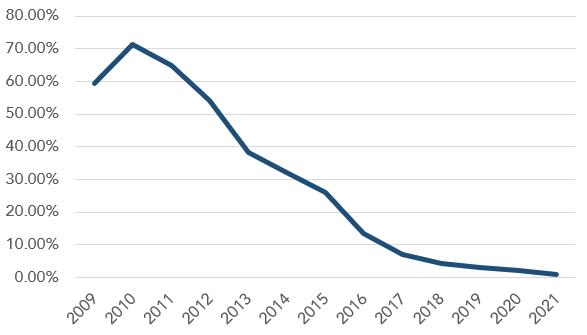
Source: Orlando Regional Realtor Association.
Although the new housing inventory is seen as the means to accommodate growth, the market for existing homes represents the dominant segment of transactions. Both the new and existing segments are experiencing price increases well beyond historical levels and supplies of either kinds of property are very tight.
Data for the last fifty years for Orange County shows a few peaking periods of permit and construction activity with the latest experienced just prior to the recession. Recent years barely exceed production of the 1970’s and are well off the peak of the boom period. The trends in both single and multifamily production in Orange County match the national trajectory described earlier and lag population growth.
The subsequent declines of new inventory from 2008 -2021 in Orange County also follow national trends, exacerbating the shortfall. The cumulative deficiency of needed units simply cannot be satisfied at the rate of production. Locally, there would appear to be a deficit ranging from a minimum of 9,300 units to a high of about 26,500 units as the result of the observed drops in activity over just the last few years. In Florida and Orange County, housing population relative to population changes has moved steadily downward.
Source: HUD-SOCDS; GAI Consultants.

Source: HUD-SOCDS; US Census Bureau; ESRI; GAI Consultants.

Source: HUD-SOCDS; US Census Bureau; ESRI; GAI Consultants.
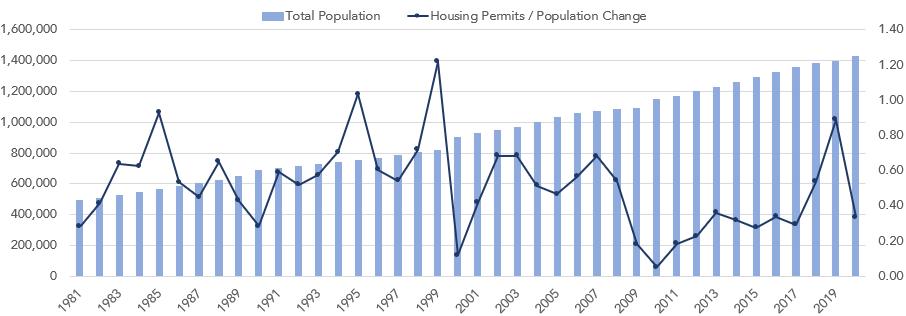
Source: HUD-SOCDS; US Census Bureau; ESRI; GAI Consultants.
Figure 12. Florida Single Family vs. Mutli-Family Units, 1980–2020
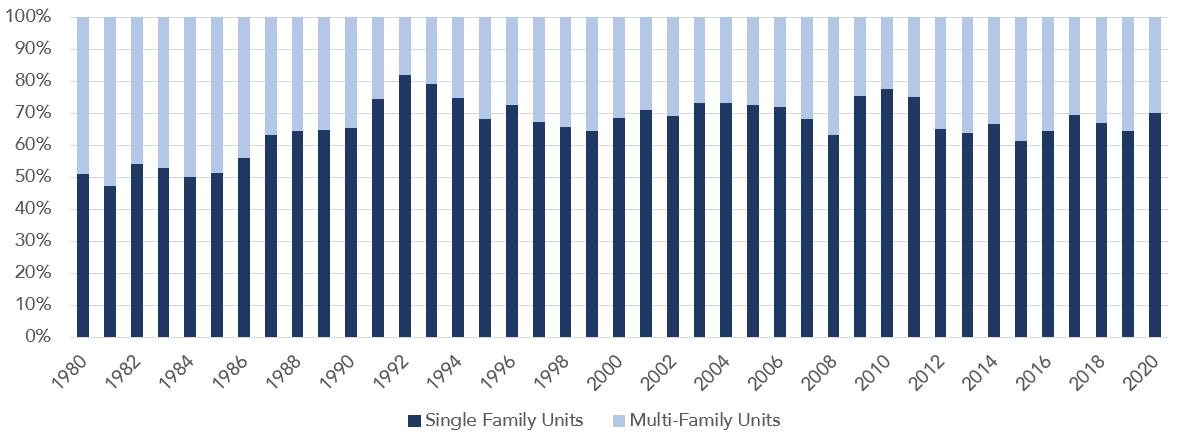
Source: US Census Bureau; ESRI; GAI Consultants.
Figure 13. Orange County Single Family vs Multi-Family Units, 1980–2020
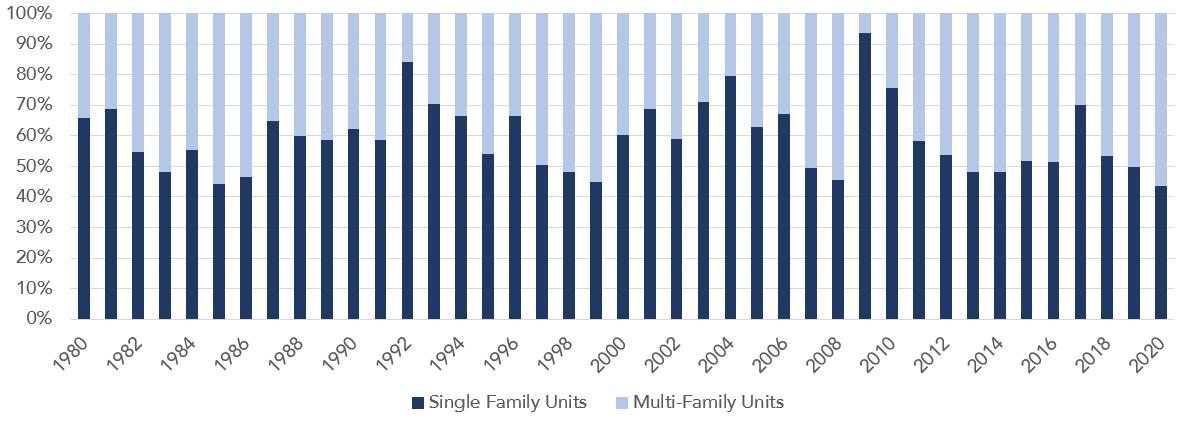
Source: US Census Bureau; ESRI; GAI Consultants.
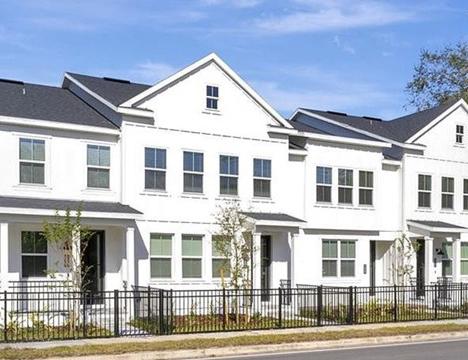
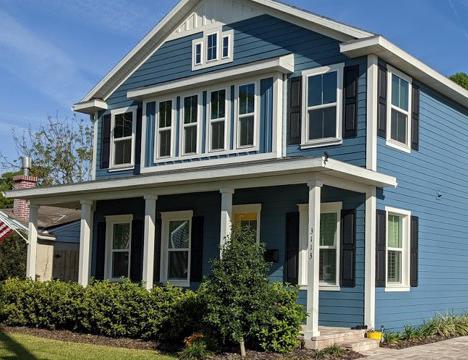
While there are limitations in the data provided by Orange County’s Multiple Listing Service (MLS), it does offer some perspective on the numbers of transactions and the growing prices over the last the last few years.
These growing prices are generally commensurate with the reduced number of new home deliveries which then place further stress on the existing segments as more buyers compete for a smaller number of homes.
This empirical, although highly anecdotal, competition for owner occupancy spills over to the rental market. As prospective buyers are crowded out or priced out of ownership opportunities, they shift their demand to rental properties. These collective actions and movement, not an isolated marketing strategy, then drive up prices in the rental segment.
The rental segment is comprised of centrally controlled, and professionally managed apartment properties, but it also includes single-family homes, condominiums and many small multifamily properties. While the proposed rent stabilization measure(s) generally targets highly visible rental apartments, they are but one layer among several that contribute to rising rents with the remainder not easily controlled or regulated by the proposed rent stabilization measure(s).
For example, property insurance rates in Florida are among the highest in the United States, affecting renters, owners, and commercial property owners. For commercial properties rates will continue to increase in 2022 having already increased in 2021 some 10-15%. In concert with higher utility costs and the growing costs of other line items, operating performance is impacted, affecting some properties more so than others.
To the degree that larger owners are visible in the marketplace, they become strongly associated with concerns about rising rents generally. At least two major property groups, Camden Property Trust and Blue Rock Residential, have been identified as corporate owners with unusually high rents
and a disproportionate influence on rental conditions locally. The Orlando holdings represent just a small part of each company’s portfolio, 13% and 6% respectively, and their rents appear to be in line with similarly oriented and aged properties in the area.
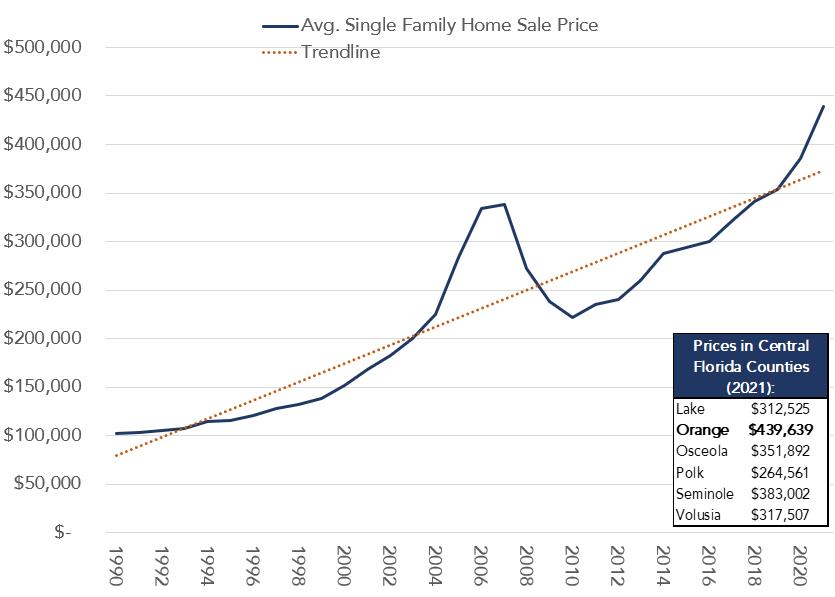
Given these and like (mis)impressions, about local market conditions, it is worth comparing housing prices, incomes, and cost burdens in Orange County with other high growth areas. Some of these other locations or metropolitan areas have been named in general interest publications and the media but without consistency,uniformity or ties to other measures to give further context or understanding. Here, other counties of approximately the same size and rates of growth are compared.
In comparing this group of communities, each with a central city of significant size, it is striking how similar many of the indicators or measures are. The following observations in particular are notable:
▪ Orange County and most other comparable counties within Florida are facing the same rent, cost, and delivery issues faced by other rapidly growing communities.
▪ These deeply imbedded structural conditions have been emerging since at least the year 2000, affecting some areas more adversely than other. However, overall each area is affected the same way.
▪ In California where rent control measures are in widely place, it is striking that the trajectories are not obviously any different than those in areas without rent control measures.
▪ Across all communities there have been sharply increasing populations with additional production, but production has been inadequate to keep pace with population growth.
▪ In all communities, percentage of renters as a share of total households is increasing. Simultaneously, rents in each of these communities are also increasing. In the last year (2020-2021) rents have increased at rates in excess of 20%, though historically increases have remained below 5% and in individual years may have declined.
▪ It is not surprising that both Camden Property Trust and Blue Rock Residential operate properties in several of these markets , all characterized by high growth and demand.
Figure 16. Comparison Counties: Population and Housing Unit Growth (2000–2020)
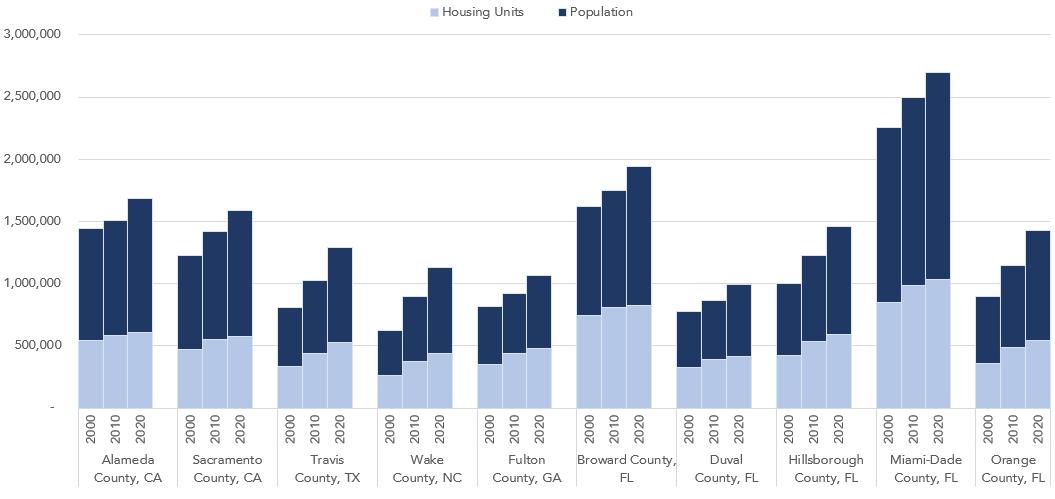
Source: US Census Bureau; ESRI; GAI Consultants.
Figure 17. Comparison Counties: Asking Rent/Unit vs. Occupancy (2010–2021)

Source: CoStar; GAI Consultants. Note: full size graph may be found in Appendix B

Figure 18. Comparison Counties: Median Household Income (2000–2020)
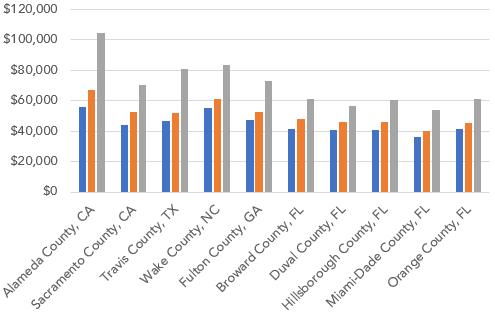
Source: U.S. Census Bureau; GAI Consultants.
Figure 19. Comparison Counties: % Renter Occupied Housing (2000–2020)
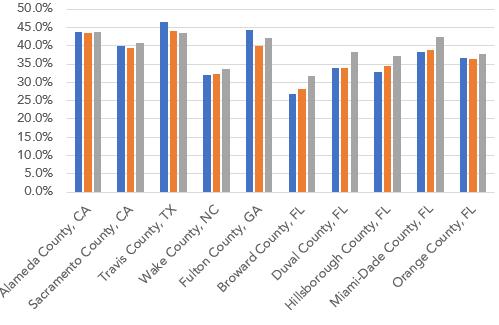
Source: U.S. Census Bureau; GAI Consultants.
Figure 20. Comparison Counties: Median Gross Rent (2020–2020)
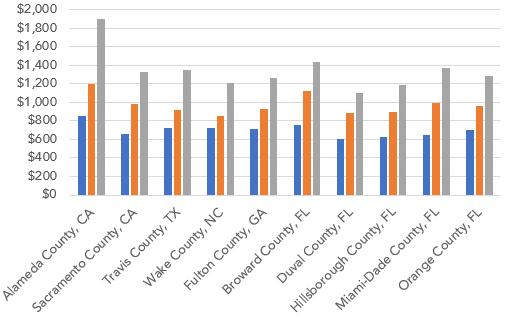
Source: U.S. Census Bureau; GAI Consultants.
1. The social challenges wrought by evictions, homelessness and unstable school populations are troubling and properly the subject of concern.
2. That said, none of these indicators show a sustained and upward trend and, in cases, have gone both up and down in the context of many varied conditions. Generally speaking, the absolute numbers for all indicators have remained about the same. If compared to population, the conditions would reflect an almost immeasurable change.
3. The financial resources of individual families and persons have ebbed and flowed in the context of diverse economic conditions both good and bad. Whatever the (1) numbers of persons affected and (2) the severity of those so affected, it is far less than clear that the conditions stem from spiking rents.
It would be a mistake to dismiss the many reports and stories about families in obvious economic distress and the implications of that distress. The bigger questions for the immediate concern are whether these events are more than occasional, widespread, and beyond some community standards or measures. The indicators suggest recent conditions today are not materially different than in prior years or periods.
With the housing and financial situations so widely covered in the media, it is instinctive that a variety of social indicators would also be adversely affected. Despite the anecdotal incidents, data identifying (1) metrics
deemed to track social conditions or (2) resources to mount interventionist strategies offer evidence that many family situations are being managed within the existing framework. In some cases, depending upon the point of reference, the actual numbers of filed cases or persons so effected have declined or remained about the same.
Beginning with evictions, the recorded filings in Orange County are up in 2022. During the first quarter of 2022, there were more than 3,100 filings associated with evictions. That compares with more than 2,300 filed with the court in 2021 in the same period when, given legal constraints, it would have been more difficult to remove a resident from possession. Over the course of the year, about 49-50% of those filings might result in an actual notice to vacate the property.
Source:
Figure 22. Writ of Possession 2021–2022 Monthly Breakdown
Writ of Possession 2021-2022 Monthly Breakdown
Evictions filed with Orange County Clerk of Courts # of Writs % Served
January 860 332 39%
February 748 388 52%
March 751 423 56%
April 619 319 52%
May 503 300 60%
June 617 392 64%
July 641 279 44%
August 697 419 60%
September 784 464 59%
Source: Orange County; GAI Consultants.
Because legislation or rules related to the COVID-19 Pandemic limited efforts to evict any resident from property, comparisons with 2020 or 2021 are probably misleading. Eviction related filings peaked in the years immediately following the recession, staying above 12,000 from 2009 to 2014, then staying at about 10,000-11,000 from 2015 to 2019 with relative consistency until COVID-19 Pandemic controls altered the trajectory. At the pace of the last few months, the numbers would be up moderately but not dissimilar to those recorded prior to pandemic constraints and almost identical to figures from 2019.
Whatever the number, neither filings nor actual evictions address reasons for action. The reasons may be associated with a variety of issues including property damage, pets, criminal activity, and non-payment as well as some combination of factors. Although financial resources strained by spiking rents could be a factor in some cases, it is absolutely not correct to conclude that those rents are the primary cause. Certainly, it would be a mistake to conclude, they are the only cause.
23. Evictions
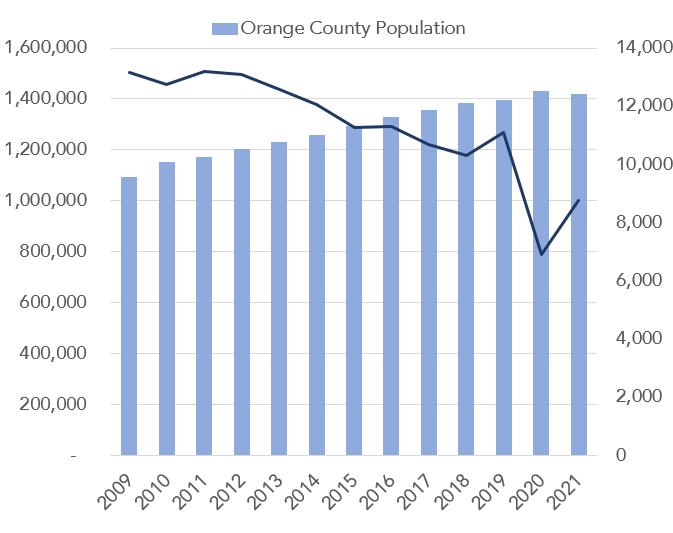

Each year, typically in January, (“Point in Time” or “PIT”), social providers make an estimate of the population in a homeless condition. Effectively, it is a crude census of that population but it is a reasonably consistent effort to capture the problem at a point intime.
For the years PIT data has been made available, the homeless population appears to have peaked during the recession at almost 58,000 people, intuitively in concert with other data from that timeframe. For the most part, the number of homeless has steadily trended downward. To the current problem, during the 2021 count, the number of homeless was estimated at 1,162 people in Orange County and 21,141 statewide. These are both drops from 2020 when the figures
were 1,401 and 27,679 people for Orange County and the state of Florida respectively.
The Homeless Information Management System (“HIMS”) also maintains a count of people in and out of homelessness in a specific year. These counts are tabulated differently than PIT counts and do not reconcile fully to that dataset.
The HIMS tabulates movements into homelessness with the data recorded to avoid duplicates. Because of the way these records are organized, they may be a more reliable indicator of homelessness.
Using these counts, the homeless figure peaked in 2019 at about 5,003 people, dropped to 3,587 people in 2020 and grew again to 4,317 people in 2021. The latest
Source: Orange County; GAI Consultants.
numbers are down from both 2017 and 2018. Pre-COVID, during COVID, and post COVID, these counts have remained relatively the same. Among children, the counts are virtually unchanged.
Source: Orange County; GAI Consultants.
Like eviction records, neither dataset tracking the homeless population addresses identifiable or significant causes. The causes are many and well documented in academic and empirical studies. While housing costs are likely a factor in some cases, it is incorrect to conclude they are the primary cause of homelessness, and it is absolutely an error to conclude, they are the only cause.
The concern about students being displaced from their stable living arrangements is also not a new phenomenon. All school districts in Florida, file an annual report on these conditions as part of the McKinney Vento program. The information identifies school age children who have experienced homelessness over the course of the year. Though counts reflect a significant decline over the last 4-years, counts were highly impacted by conditions occurring beyond the control of Orange County Public Schools (“OCPS”). These conditions include Hurricane Maria which struck Puerto Rico during the 2017/2018 school year displacing student from Puerto Rico to school districts throughout Florida, and the COVID-19 Pandemic which resulted in substantial undercounting in the 2019/2020 and 2020/2021 school years due to expanded
virtual education options. The 2018/2019 school year counts were not significantly influenced by outside forces and reflect the norm more typically observed by OCPS and are consistent with current school year counts to-date of 5,634 students Even with student homelessness within the Orange County School district expected to return to preCOVID-19 Pandemic levels for the 2021/2022 school year, it is not a condition easily traced to rising rents.
Source: Orange County; GAI Consultants.
1. As early as 2016 Mayor Jacobs started the Regional Affordable Housing Initiative (“RAHI”) drawing on the resources of multiple jurisdictions.
2. Mayor Demings and his contemporary BCC members launched Housing for All (“HFA”) to implement much of that strategy.
3. In the wake of both, the County adopted measures to support a range of affordable and attainable housing product.
4. For its part the County has been involved with actions or production associated with more than 2,000 units since 2021, a major increase in affordable deliveries over the last several years and a significant share of production without regard to the segment served.
5. For the short term, emergency dollars have been available to address renter needs. Those efforts are being complemented by others including Universal Studios and possibly Disney who could also move into affordable and attainable housing in a very visible way.
6. All of these efforts individually and collectively focus on very narrow segments of the lager market which are still producing fewer units than they have historically.
The housing challenges so evident today, as a result of the attention centered on sharply increasing rents, are not new.
These challenges have been a growing and visible concern for several years and were a topic given priority by Orange County leadership, beginning in 2016 under Mayor Teresa Jacobs. At that time, the various market issues, production costs and barriers, lag in housing deliveries, burden of personal resources allocated to housing of all kinds, and appropriate or viable roles for Orange County and nearby governments [City of Orlando, Seminole County, Osceola County] were the subjects of extensive analysis and policy deliberation. The findings of this early effort were compiled into the RAHI and formally adopted by the BCC at the time it was published.
Mayor Demings and all the current members of the BCC retained housing as a major policy priority adopting HFA. The HFA initiative provided goals and a comprehensive strategy that included regulatory solutions and, in particular, allocated funds specifically to advance those goals. If financial resources are a measure of pollical commitment, the creation of the County’s Housing Trust Fund (“HTF”) is significant because it has allowed the County to partner and facilitate in a number of housing projects or activities that might otherwise have been impossible.
The impact of the HTF on local activity can be gleaned from the data below which is an inventory of all Affordable Housing (rent or income controlled) provided or retained since 2016. The role of the HTF is evident in deliveries over the last 1-2 years is evident, contributing to the planning and construction of more than 2,000 units over the next 18 (estimated) months. In prior periods, without the fund, Affordable Housing deliveries were a fraction of that figure.
In the near term, Orange County has authority to distribute many millions of dollars in direct rental payments to households and property owners overwhelmed by COVID. This program, while an obvious nod to short term needs, also illustrates the inherent difficulty in assuring access on an ad hoc basis.
While it is premature to ascertain exactly how County funds or County leadership will support lower cost housing in the future, there have been significant positive actions to this end. Universal Studios plans to develop about 1,000 units of affordable/attainable housing. Disney has also announced plans for several thousand units. Orange County has its own plans for the International Drive Community Redevelopment Area (“I-Drive CRA”) , which combined with other activity will add significantly to the affordable/ attainable housing inventory. The I-Drive CRA Redevelopment Plan identifies $22.5 Million for affordable/attainable housing within I-Drive Catalytic Sites and references need to encourage/induce production of 1,600 such units throughout the I-Drive CRA. In addition These are substantial numbers in the context of a market that has historically been slow to respond to the affordable segment.
Viewed in the context of the older RAHI and the newer HFA, all of these units are rationally counted as part of the many housing goals targeted by the County. At least for the foreseeable future, Orange County has orchestrated a very aggressive and comprehensive strategy.

1. The State’s legislation allows local governments to impose controls on rents during certain grave housing emergencies.
2. Required to make recitations and findings establishing the existence in fact of said grave housing emergency.
3. Provides for exemptions of certain units and provides a definition of luxury apartment building.
4. At the time of the legislation, that definition identified luxury units as those priced at monthly rents exceeding $250 (1977) although there is no express prohibition to make an adjustment to current dollars.
5. Commissioner Bonilla’s suggested approach would apply any potential rent stabilization measure(s) only to those properties with 4 or more units.
6. Must make and recite findings that such rent controls are necessary and proper to eliminate the grave housing emergency.
7. The proposed rent stabilization measure(s) might last longer than a year based on a cycle of renewed leases or other considerations.
The following passages are extracted from Section 125.0103 with emphasis on the substantive dimensions, issues, or considerations addressed in the current analysis.
(2) No law, ordinance, rule, or other measure which would have the effect of imposing controls on rents shall be adopted or maintained in effect except as provided herein and unless it is found and determined, as hereinafter provided, that such controls are necessary and proper to eliminate an existing housing emergency which is so grave as to constitute a serious menace to the general public.
(3) Any law, ordinance, rule, or other measure which has the effect of imposing controls on rents shall terminate and expire within 1 year and shall not be extended or renewed except by the adoption of a new
measure meeting all the requirements of this section.
(4) Notwithstanding any other provisions of this section, no controls shall be imposed on rents for any accommodation used or offered for residential purposes as a seasonal or tourist unit, as a second housing unit, or on rents for dwelling units located in luxury apartment buildings. For the purposes of this section, a luxury apartment building is one wherein on January 1, 1977, the aggregate rent due on a monthly basis from all dwelling units as stated in leases or rent lists existing on that date divided by the number of dwelling units exceeds $250.
(5) No municipality, county, or other entity of local government shall adopt or maintain in effect any law, ordinance, rule, or other measure which would have the effect of imposing controls on rents unless:
(a) Such measure is duly adopted by the governing body of such entity of local government, after notice and public hearing, in accordance with all applicable provisions of the Florida and United States Constitutions, the charter or charters governing such entity of local government, this section, and any other applicable laws.
(b) Such governing body makes and recites in such measure its findings establishing the existence in fact of a housing emergency so grave as to constitute a serious menace to the general public and that such controls are necessary and proper to eliminate such grave housing emergency.
(c) Such measure is approved by the voters in such municipality, county, or other entity of local government.
(6) In any court action brought to challenge the validity of rent control imposed pursuant to the provisions of this section, the evidentiary effect of any findings or recitations required by subsection (5) shall be limited to imposing upon any party challenging the validity of such measure the burden of going forward with the evidence, and the burden of proof (that is, the risk of non-persuasion)
shall rest upon any party seeking to have the measure upheld.
(7) Notwithstanding any other provisions of this section, municipalities, counties, or other entities of local government may adopt and maintain in effect any law, ordinance, rule, or other measure which is adopted for the purposes of increasing the supply of affordable housing using land use mechanisms such as inclusionary housing ordinances.
GAI has worked with Orange County’s legal counsel to ascertain the legal significance of these highlighted passages in terms of our data collection and analysis. However, legal guidance in applicable cases is limited and invites debate.
▪ The Statute speaks to a housing emergency, and the governing body makes recitations and findings related to the emergency.
▪ The Statute is intended to provide temporary relief, but it is not clear if the year specified is a true calendar year beginning with adoption or a period of a lease which is often a year or more. If the latter, any emergency measure could extend the period of coverage to as much as two or more calendar years in accordance with individual lease renewals.
▪ The Statute provides for exemptions of certain units and provides a definition of luxury apartment units.
▪ The state allows for certain exemptions and exclusions based on the nature of the unit or its rents. Among those exclusions are so called luxury apartment units. These units are those where the aggregate rent exceeds $250.
▪ Because a specific date is inserted in the statute, it can be reasoned that legislation only targets those units in existence on January 1,1977.
▪ BCC must make and recite findings that the proposed rent stabilizations measure is necessary and proper to eliminate the grave housing emergency.
1. Multiple scenarios were considered. These scenarios relate to the identified average rent and the kinds of properties with four or more units
2. They do not include properties already subject to certain income or rental exclusions.
3. There are approximately 230,000 renteroccupied households in Orange County.
4. Without regard to the cap, there are approximately 158,000 multi-family rental units (market priced and assisted in some way) that would meet the size criteria, accommodating some share of these households.
5. Because Section 125.0103 is subject to some interpretation, we prepared multiple scenarios for analysis. Only one scenario is likely to generate a substantive response in the larger market. The other scenarios seem small relative to the conditions necessary to eliminate any emergency. The most limiting quantitative issues are associated with the number of units potentially affected by the proposed rent stabilization measure(s). The count of those units is subject to some interpretation. Effectively, there are various interpretations that increase or decrease the pool of units to be controlled. Those interpretations focus on the date the legislation was enacted and the explicit rent stated in the statute.
▪ Scenario 1: All units held to the $250 maximum stated in the statute. Only units renting for less than that figure would be subject to controls. Today, virtually no rental units are available at that price. Significance: No units are available or subject to controls.
▪ Scenario 2: The rent stated in the statute is adjusted to reflect either a price inflator or to reflect a share of income allocated to rents consistent with the burden implied in the statute adopted in 1977. In the case of the former, only units renting for less than $1,212.46 would be subject to controls. In the case of the latter, only units renting for less than $1,002.68 would be subject to controls. That figure is the equivalent of no more than 20% of the median income. Significance: A range of some 4,800 units to 12,900 units is available or subject to controls. The lower end of the range strictly ties rents to income without consideration of time.
▪ Scenario 3: For units in existence on January 1, 1977, the cap is held to the $250 maximum stated in the statute. No caps on units established after January 1, 1977, because none are indicated. Significance: Approximately 103,900 units are available or subject to controls.
Each of the potential interpretations are summarized by year and presented in the table on the following page.
Source: CoStar; GAI Consultants. Note: Affordable Units Excluded.
Scenario 2 as a middle course, is useful and plausible for planning purposes. But, like the other scenarios, it is a legally, untested position.
Anywhere within the range of Scenario 2, the number of units relative to the total inventory of rental units is small, topping off at 5.6%. Whatever the number, the market share of the affected market is so small that it would be challenging to reason that the affected inventory mitigates an emergency across a substantively of broader community.
As the proposal has been drafted, whatever the higher costs of operations stemming from utilities, insurance, taxes, or other rising costs, these would entirely or almost entirely be carried by the property owner.
Figure 27 below reflects the distribution of properties containing all 131,654 units described in Figure 26 as they relate to the various incorporated jurisdictions within Orange County.
1. The academic literature is altogether in concert with empirical observations about the consequences experienced in settings where formal rent control measures have been adopted.
2. The major benefit reported is the obvious one: dampening effects of rents on a discrete pool of units. Whatever the significance and magnitude of this benefit, it is a product of well-developed control systems, and it disappears rapidly.
3. These effects stem from programs in effect for years with elaborate design, regulations, and administrative controls
4. They have shown some very short term effects, notably on certain properties and certain rents with the effects receding rapidly.
5. Many more costs, both direct and indirect are reported with the primary ones centered on lowered inventory, declining maintenance, less competitiveness based on quality of maintenance, and potential disinvestment in neighborhoods.
6. The benefits of controlled rent seem to be experienced primarily by better informed, more mobile, and more affluent households.
7. A comprehensive approach is needed to address rising housing costs, but a rental cap alone is among the least effective.
Much has been written about the nature and effects of various rent containment efforts over the last twenty years but only some of it arising from analysis subject to peer review.
For purposes of this report, peer review materials were studies extensively. By definition, these materials largely exclude the occasional, anecdotal, and often biased observations of groups aligned with certain interest or positions. For the most part, only key findings developed in the last fifteen years were considered. This period coincides with the external conditions impacting the immediate term generally but in several cases includes the last recession as a major contextual influence. Collectively, this and other information substantively shapes the broader analysis.
Not surprisingly, the information available centers on programs in Massachusetts, California, New York and Washington DC which adopted a form of rent control of various kinds in the wake of World War II. Oregon adopted a rent control measure in 2019 but effectively the statute targeted Portland. Nominally all center on the control of rent within certain prescribed limits but without exception the legislation adopted is comprised more than simply rent caps. All legislation draws upon a range of tools to manage costs, violations, and opportunities to make adjustments. These programs are complex, involving an extensive administrative structure to manage the rental ceiling itself. To date, those findings speaking to positive effects are mixed at best.
The most compelling argument is that they inject a social or human dimension into economic policy. However, there are no sweeping findings suggesting the broad
efficacy of rent control implemented through thoughtfully developed processes. Certainly, there is no research to support a single year stay as the basis for longer terms results. In the main, the benefit of existing programs are evidently very short term, vanishing almost immediately. Those benefits that can be established then generate a variety of extremal consequences, mostly in terms of maintenance declines and dampening inventories in some classes of property that might undermine the social dimensions. For the persons involved in the cited research, a combination of direct construction assistance to induce supply and direct supports to targeted populations appear to be a more efficient strategy. Neither, by itself, is likely to have the desire effects of creating adequate housing options to match the needs of targeted populations.
While not capturing all of the newest publications, various subjects pertinent to the present conversation have been addressed in the several documents accessed. These subjects include the impacts on spiking rents which is the central issue in the proposed ordinance as well as a variety of related or spillover effects that may be less pivotal. The latter subjects include homelessness, the ideological dimensions of rent controls, ties to certain racial or income attributes, household stability, declining housing deliveries, and the eroding quality of the rental inventory.
Sims (2006) takes advantage of rent controls ending in Massachusetts to conclude that state’s program had little effect on the construction of new housing but encouraged owners to shift units away from their status as rental properties, offsetting gains in inventory. Rents appear to have abated substantially over the longer term from 1985 -1998 and may have influenced rent setting on units otherwise not subject to direct controls. He reports that rent control led to deterioration in the quality of rental units and is associated with lower rent turnover.
Autor, Palmer, and Patak (2015) also take a look at Massachusetts but focus on the period subsequent the removal of controls. They believe the inventory described by Sims was indeed lower that it may have been otherwise, noting the surge in activity following the end of rent controls. They also point to renters leaving the areas or neighborhoods where rent controls may have been most pronounced while indicating that larger neighborhood investments were then feasible in the period after controls ended.
According to Sommer and others (2013), rising interest rates generate effects for ownership and rental housing that must be explored together because production for both is constrained. For the former, home prices may fall form increased interest rates but those declines do not make ownership units more affordable given the higher costs of mortgage loans. Until they do become more affordable, they drive households into rental units initiating heightened demand for that kind of product forcing those prices upward.
German researchers (Briedenbach, Eilers and Fries, 2022) reflect on the experience of rent controls in their country. Understanding the housing dynamics in Europe likely lack the attributes of markets in the United States, they have done a careful study of new shocks created by rent controls there. Noting that impacts were immediate, they also point out the pricing advantages vanish entirely within 10-16 months of implementation with the effects primarily benefiting more affluent households. Like Sims (2006), they find a deterioration in quality of the rental inventory. Ultimately they conclude rent controls are” a short lived and incomplete answer to the problems of rising rental rates…rent control cannot be the single solution…”
Another European analysis focuses on Oslo Oust (2017) and his notion that rent controls limit rent information because outreach mechanism are not needed. He concludes that one irony of forced rent structure is that
rental seeking is more difficult. In his research, he asserts locational choice is limited and often pushes prospective renters away from locations more accessible to their jobs and social connections.
California has had rental controls for several years but the focus of legislation changed in 2019 with laws capping rents statewide based on a combination of inflation and profitability. Diamond, McQuade and Qian (2019) explore housing controls in San Francisco, among the highest cost housing markets in the United States Like Autor, Patak, and Palmer (2015), they offer perspective on such controls as quality of life matters as well as additional information on their impacts to the housing inventory. Generally, they report the benefit to households who are able to more consistently lower their movements from one unit or neighborhood to another increasing their social capital. These effects are more likely to be experienced by racial minorities who might otherwise be displaced.
In that context, Autor, Patak, and Palmer suggest that landlords and property owners seek better real estate investments, including the conversion of rentals to ownership properties. While they believe a large supply of housing may have simply not been constructed, they estimate conversions reduced the inventory by 15%. It is an oddity of the potential gains and losses that inequity and gentrification appear to have increased: as costs are controlled in certain areas, (1) lower income families are locked in place while (2) higher income households have freedom of movement to neighborhoods with amenities and physical improvements. To the degree that renters in place may gain advantages and would likely vote affirmatively for such controls, their votes push out new renters with no voice. Votes for rent control, they observe, “appear to be an inefficient way to set rent control policies”.
Unfortunately, peer reviewed research offers little insight into the relationship between homelessness and rent controls. Other than
anecdotal, there is little detailed information on this subject.
The absence of such investigation may itself suggest the paucity of basic foundations on which to develop a working hypothesis. Rather than avoiding the subject entirely, we did query more generalized publications and articles. Not surprisingly, rent burden is associated with potential homeless issues but it has not been separated from other influences.
The following points have been (re)tested in some detail, are worth emphasizing, and should substantively influence the broader conversation.
▪ Rent controls in place largely arise from very carefully crafted legislation.
▪ Whatever the significance and magnitude of stable rent, it is a product of welldeveloped control systems, and it disappears rapidly.
▪ The benefits of controlled rent seem to be experienced primarily by better informed, more mobile, and more affluent households.
▪ To the degree there are other benefits, they too occur in the context of well-developed control systems that are not feasibly crafted or deployed in one year.
▪ A single year seems a virtual impossibility to achieve goals.
▪ Many costs are reported with the primary ones centered on lowered inventory, declining maintenance, less competitiveness based on quality of maintenance, and potential disinvestment in neighborhoods.
▪ There is almost no indication that homelessness would be resolved other than in the most particular instances.
A comprehensive approach is needed to address rising housing costs, but a rental cap alone is among the least effective.
1. There are several existing programs providing various forms of rental relief but these are substantially different than the nominal strategy proposed for Orange County and permitted by Florida law.
2. In these other settings, rental caps per se are just a very small part of a much more elaborate price control strategy.
3. The fuller strategy reflects adjustments in excess of inflation, costs for insurance, cost for taxes, and costs for utilities. Section 125.0103 is effectively silent on what comprises rent. These programs have taken years to organize.
4. These programs also require an extensive bureaucracy and infrastructure to routinely analyze, administer, report, and enforce. That comprehensive approach is not a part of the strategy envisioned here.
5. The limited time frame makes it virtually impossible to create a minimally supportive framework.
6. As with most social and economic measures, there are claims from both supporting and opposing groups. Modest rent containment appears to be a real observable benefit for certain populations, possibly achieved without total market disruption.
7. With some limitations, these specific observations are confirmed in the extensive body of controlled, peer-reviewed academic research.
8. Where benefits might be experienced, the effort requires substantial intervention, not nominal rent ceilings.
9. The information gleaned from existing programs here largely supports the conclusion that any advantages gained may be mitigated or offset by the disadvantages.
What follows is a brief discussion of rent regulations occurring in other settings. It would be a mistake to describe our description of these programs as comprehensive. However, these empirical observations provide added perspective on the proposed rent stabilization measure(s) in Orange County, especially in the context of the research already described in Section VII.
While controls in New York date to housing shortages after WWII, the evolution of these programs in several locations is more typically associated with the higher-thanaverage housing costs which have existed in these settings over a later, but still extended, period. Whatever the current Florida situation, those costs were far greater in relative and absolute terms, evolving into a structural condition. Effectively, the programs created were intended as long-term approaches to a seemingly permanent problem.
Like Florida, the private market never addressed low- income housing adequately in these settings with a history of substantial housing need. As direct federal resources for housing declined and were replaced by tax credits, the housing needs in many of these states or municipalities were further undermined generating calls for rental relief. While other programs exist in these settings, unlike Florida they do not have the equivalent of the Sadowski fund to support housing.
As of 2022, approximately 200 municipalities across the United States have a form of rent regulation. Most are located in California. The programs in New York, Los Angeles, and San Francisco are among the program most often cited or analyzed. It is estimated that in 1995 10-15 percent of the housing inventory in the United States was subject to such controls.
Oregon and California have recently created or modified programs that operate at the state level to assure some uniformity in controls and regulations across all municipalities. We are not well informed on the means by which existing municipal program will be brought into conformance with state systems or if they must comply. Given the intervening recession and COVID-19 Pandemic periods in which these launched, they are of less value for benchmarking. As well, it would be wholly speculative to explore the implications for local variations already operational when the state programs were implemented.
Massachusetts, however, had a very elaborate program abandoned in 1989. In our literature review, the Massachusetts experience is documented in fairly extensive controlled research and case studies across multiple time periods.
Elsewhere in the developed world [G-7 countries such as Canada and Norway for example] there are also rent control programs. These are not described here but, like other programs, they have been the subject of extensive research and investigation.
Rent regulation programs profiled take many forms. What is common among them is that they are complex and have a number of institutional dimensions. In that mix of rules or controls, the actual ceilings imposed on rents is one factor among many. How these various dimensions combine functionally as a strategy appears to be a substantive departure from what might be possible in Orange County.
The programs profiled vary by how they calculate cap rent increases. Most of them tie the cap to the Consumer Price Index (CPI), a widely used measure of inflation. The most restrictive programs set the cap at a percentage of the CPI, while more lenient programs set the cap at the CPI plus an additional percentage point increase. The wide range is illustrated by Berkeley, California, where rents are capped at 65% of the CPI, and the state of Oregon, which allows rent increases at the CPI plus 7%.
Importantly, many of the programs consider added costs that can impact the ceiling. That is, several incorporate a specific and detailed process for exceptions and appeals, permitting the owners to pass through costs for a range of items which have a direct bearing on total costs and impact subsequent investment returns. The more common are allowances for major capital improvements, utilities increase, and property tax hikes. Some programs allow owners to appeal on the basis of a “right to reasonable return,” which granting the owner a base return from the property. Even if exceptions are applicable, the programs nevertheless limit the total increase that an owner is allowed.
The above notwithstanding, various exemptions to rent caps exist. The most common is an exemption for new construction. Some programs also exempt small (less than four units) buildings, either across the board or when owner-occupied. Effectively, “new units” already enjoy a cost and timing advantage.
The temporary nature of a lease provides opportunities in several cases to escape the controls by triggering a reset of rents for new occupants. Not atypically, such programs allow a landlord to return the rent to market level when a tenant vacates the unit. The maximum advantages of avoiding such growing rents would likely be realized by those residents staying in place. In that case, household stability is improved, maintenance might decline, and mobility is restricted.
Programs vary by how compliance is monitored and how disputes are handled. Approaches are widespread among the many programs in existence. Some programs require tenants to initiate complaints and challenges while others establish more proactive implementation compliance programs.
Some include extensive educational and training programs. The various dimensions of these several tools or strategies and their interaction are nicely illustrated in a report prepared by researchers In Minnesota.
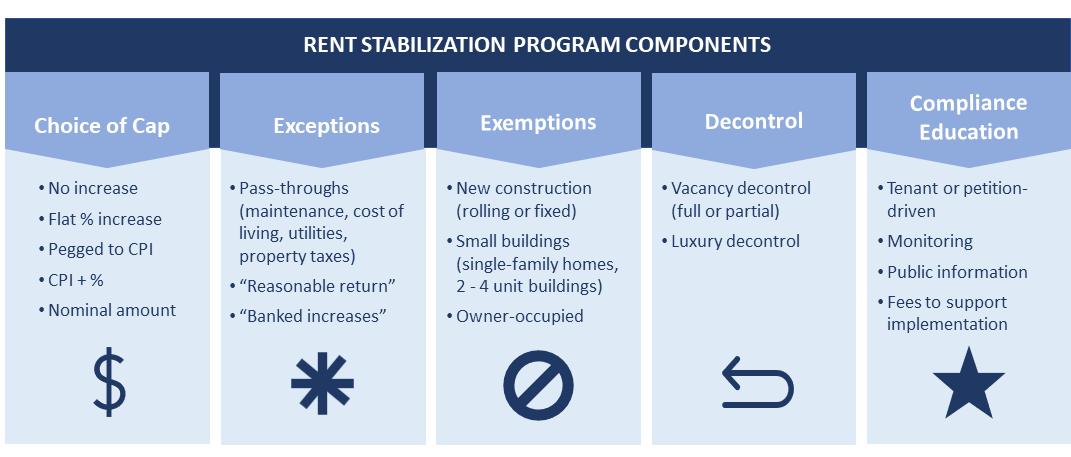
The comments, support and criticisms about these programs generally reflect strong positions of industry or trade groups and civic or consumer advocates. The broad observations associated with these rent control strategies may include some thoughtful evidence but clearly they need to be unpacked and evaluated in terms of their constituency. Many comments are simply opinions or anecdotes.
Below are several key points relevant to the rent stabilization measure(s) being considered.
▪ Some groups and analysts indicate that rent regulations have been effective at achieving two of their primary goals for at least a period of time: maintaining below-market rent levels and moderating price appreciation. That observation is almost certainly correct but applies to
a small segment of the rental inventory while overlooking other issues. Generally, places with stronger rent control programs [more elaborate or with fully developed infrastructure] have had greater success in preventing large price appreciation than weaker programs. That success is not evenly experienced across units of all ages and condition.
▪ There is some agreement by these same observers that rent regulation can increases housing stability for those who live in regulated units. The benefit of stability, according to others, is offset by imposing limits on mobility and access to alternatives.
▪ The impact on new construction is widely debated. New units have been added to all locations where rent controls have
been imposed. Where new housing deliveries enter the market, they are driven by localized economic cycles, credit markets and informed actors. It is likely that some housing has been discouraged, especially in those setting with marginally supportive economic conditions. To be sure, rent controls are only one variable in determining a feasible implementation strategy. Knowledgeable developers will navigate their way through the controls and leverage the higher price points possible with new housing. Clearly some developers do.
▪ To the above point, many jurisdictions with rent stabilization specifically exclude new construction from controls, either in perpetuity or for a set period of time. This gives new rental deliveries an inherent strategic and pricing advantage that doesn’t extend to all competing properties. New rental housing in these circumstances is actually boosted by controls but thwart the underlying objectives that otherwise seek to contain prices.
▪ While controls do not necessarily close the market to new units, critics claim that rent regulations are related to an overall reduction in rental units. The reductions occur as owners respond to rent regulation by removing units from the rental market via condominium conversion, demolition, or other means.
▪ The evidence that rent regulations cause a reduction in housing quality is mixed. Some advocates suggest the regulations raise the standards for all properties. This position is sustained, in part, by allowances supporting major capital improvements. These major improvement, however, are to be distinguished from aesthetic upkeep which may suffer.
▪ Even at the most casual level of observation, there is ongoing debate whether the majority of benefits from rent stabilization go to the neediest households.
▪ Despite objectives to the contrary, there appear to be a lack of consistent regulations related to the enforcement of compliance such that all reported experiences are conjectural. Some systems rely purely on responding to tenant complaints, basically a reactive system. Others are structured around detailed monitoring, evaluation, education and proactive enforcement policies.
▪ The substantively more functional programs appear to be directly related to the financial commitment to support the rent controls and the broader social objectives intended. A number of the smaller municipalities in California rely on ad hoc mechanisms while Oregon’s newer statewide program would be part of the latter.
▪ New York City illustrates the complexity of the infrastructure necessary to support an elaborate rent control program . The city maintains a Rent Guidelines Board. This Board meets regularly and annually. It is charged with producing a detailed document related to rents, housing markets, and trends to stay current and provide a transparent and effective data to support the most current factors that guide rent calibrations. In a recent study, it was determined that New York’s program had resulted in a 7.8 percent decline in net operating income (“NOI”) between 2019 and 2020, even before taking inflation into account.
In sum, rent control programs in the United States have generally developed over time, are highly evolved, and are deeply entrenched in their respective economic and political settings. The benefits that do exist appear to be highly localized and subject to contradictory interpretation. For the most part, as elaborated upon in the literature review, the claims for benefits inadequately address the conditions and externalities caused by the controls.
1. Context shaping the need for the current rent stabilization measure(s) proposed:
▪ The conditions being experienced took many years to advance to their present state.
▪ The conditions have long been tracked and extend from a series of phenomena being experienced nationwide.
▪ The conditions reported are substantially real but may be moderately exaggerated and are well out of context.
▪ Without ignoring the obvious plight of any one family or person, however, many indicators may not be an accurate gauge of the conditions described and in some cases may be declining.
▪ Where Orange County sits in comparison with other settings, it is one of several high growth regions exposed to many pressures beyond its singular ability to control.
▪ Regardless, the present conditions are not a problem centered strictly on affordable and attainable housing. They extend across a broad spectrum.
▪ Because the condition is largely structural and nationwide, an effort focused excessively on capping rents is probably not an effective solution and will likely distract attention from other programs thoughtfully designed to address the issue.
2. Local solutions which have responded:
▪ Orange County is among those jurisdictions that have noted the problems and taken an active role within the affordable housing market to address the situation, looking longer term.
▪ The County has already provided or been directly associated with over 2,000 units. Even with those programs formed or being formed, they address a very narrow segment of the market place. Programs must be considered that have broadly wider impacts.
3. Strategy and relevance of the proposed rent stabilization measure(s):
▪ There are many external factors that would be ignored by rent stabilization measure(s).
▪ The focus only on rent ignores a litany of other housing issues and expenses which are only partiality captured in “lease” cost.
▪ These issues and expenses are structural conditions in need of long terms and thoughtfully implemented solutions.
▪ Where rent controls have been imposed, results are mixed although it is obvious housing supply continues to be delivered at some level.
▪ Because the present conditions stem from a multiplicity of structural factors,
a one year solution centered exclusively on rent will almost certainly not eliminate the conditions reported.
▪ At the very least, because rent stabilization measure(s) are focused on rents of a certain date, property owners are likely to be motivated to implement rent increases in advance of an effective date.
▪ Could open the door to shorter lease terms.
4. Scale of impacts locally should rent stabilization measure(s) advance:
▪ May result in legal challenges.
▪ Orange County is acting for all of the jurisdictions within its own boundaries, all with their own set of needs and circumstances.
▪ In Scenario 3, an estimated 103,900 units could be affected for a period of time that conforms to the date of the lease.
▪ Optimistically, that term would allow the affected household to experience a period of rent relief over the full term of the lease, not just the balance of a calendar year following adoption.
▪ Applying Scenario 1 generates no units.
▪ Applying Scenario 2, an estimated 4,800 units to 12,900 units could be affected for the balance of a calendar year following adoption.
▪ In either case, the number of units impacted appears relatively and absolutely too small to meaningfully influence the “emergency” as it has been declared.
5. Other local options:
▪ Some increasing rental costs might be absorbed by federal funds allocated to the state and Orange County expressly for housing relief.
▪ In conjunction with more aggressive distribution or a re-prioritization of these relief dollars, a County policy embracing advanced notice of rent increases seems a reasonable action. Notice would also serve the resident and property owner well for planning purposes. The cost of such a policy action would be nominal for a property owner compared to a rent ceiling.
Certainly, the anecdotal information identifies people and classes of renters in particular who are facing very difficult economic circumstances. Rents are spiking and their rate of increase is especially burdensome to the least affluent populations. That said, the patterns and character of that burden have not been materially changed in the last several years despite the pandemic and its wounds to the economy.
By almost every measure or indicator, housing and social conditions are no more adverse than they have been in years. Nonetheless, they are, getting out-sized attention.
While we have not been retained to outline an alternative narrative or strategy, we believe many of the tools, resources or programs presently exist, and they require heightened support and energy to assure their effectiveness. What seems certain is that the current discussion has raised awareness of several related issues needing continued, not ad hoc, attention.
While proposed rent stabilization measure(s) focus on a narrow and discrete area, the problem is substantively greater than the solution offered or legally allowed. If a visible response is deemed necessary to rally greater support to the bigger issue, more aggressive distribution of federal relief funds and formal notice in advance of a rental increase, may be practical options.
Funds stemming from ERAP are not yet fully distributed locally and may be a source of some financial relief which ostensibly ties to the issues targeted by the rent stabilization proposal.
While requiring formal notice in advance of a rental increase is not a focus of this current work, it is a policy option that has been voiced. Obvious harms from formal notice are not envisioned since the burden primarily involves reporting or paperwork which might coincide with a new lease. While notice procedures are not free of added costs, they
would be nominal compared to a rent ceiling. Notice would also serve the resident and property owner well for planning purposes. Renters would have an opportunity to explore alternative housing options or solutions while property owners could use the advanced notice period to test prevailing trends of the marketplace.

Breeidenbach, P., Eilers, L., & Fries, J. (2022). Temporal Dynamics of Rent Regulations – The Case of the German Rent Control. Published by Regional Science and Urban Eocnomics, Vol. 92. DOI: 10.1016/j. regsciurbeco.2021.103737.
Bluerock Group. (2020). Bluerock Residential Growth REIT 2020 Annual Report. Released by the Bluerock Group. Available at: https:// www.annualreports.com/Company/bluerockresidential-growth-reit-inc.
Camden Property Trust. (2021 December 31). Camden Property Trust 10-K Filing. Released by the SEC. Available at: https://investors. camdenliving.com/investors/financials/secfilings/default.aspx.
Diamond, R., McQuade, T., & Qian, F. (2019). The Effects of Rent Control Expansion on Tenants Landlords, and Inequality: Evidence from San Francisco. Published by American Economic Review, Vol. 109, Issue 9, pp. 33653394. DOI: 10.1257/aer.20181289.
Goetz, E., et al. (2021 September 7). Minneapolis Rent Stabilization Study. Published by the Center of Urban and Regional Affairs. Available at: https://www. cura.umn.edu/research/minneapolis-rentstabilization-study.
New York City Rent Guidelines Board. (2022 February). Housing NYC Rents, Markets & Trends 2021. Released by the NYC Rent Guidelines Board. Available at: https:// rentguidelinesboard.cityofnewyork.us/.
New York City Rent Guidelines Board. (2022 April 14). 2022 Price Index of Operating Costs. Released by the NYC Rent Guidelines Board. Available at: https:// rentguidelinesboard.cityofnewyork.us/.
New York Home and Community Renewal Group. (2021). 2021 Annual Report, Office of Rent Administration. Published by the State of New York Home and Community Renewal Group. Available at: https://hcr.ny.gov/ system/files/documents/2022/01/ora-2021annual-report.pdf.
San Francisco Tenants Union. (2021). Rent Control. Published by the San Francisco Tenants Union Group. Available at: https:// sftu.org/rent-control/.
Sims, David. (2006). Out of control: What can we learn from the end of Massachusetts rent control?. Published by the Journal of Urban Economics, Vol. 61, Issue 1, pp. 129-151. DOI: 10.1016/j.jue.2006.06.004.
Smith, Ryan. (2021 January 27). Property Insurance Costs to keep rising in 2021. Published by Insurance Business America. Available at: https://www. insurancebusinessmag.com/us/news/ breaking-news/property-insurance-costs-tokeep-rising-in-2021--report-244695.aspx.
Sommer, K., Sullivan, P, & Verbrugge, R. (2012). The Equilibrium Effect of Fundamentals on House Prices and Rents. Published by the Journal of Monetary Economics, Vol. 60, Issues 7, pp. 854-870. DOI: 10.1016/j.jmoneco.2013.04.017.
Smith, Andy. (2021 Nov. 20). What Is Rent Control? Released by the balance. Available at: https://www.thebalance.com/what-is-rentcontrol-5188896.
Willis, M., & Murphy, M. (2022 April 13). The Economic Challenge for the Rent Guidelines Board: Balancing Long-Term Affordability in Rent Stabilized Housing. Published by The Stoop. Available at: https://furmancenter.org/ thestoop.
